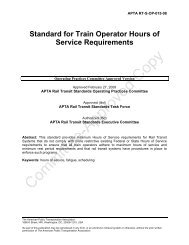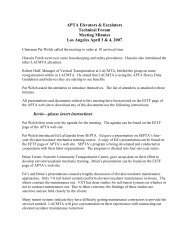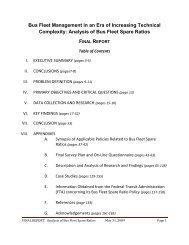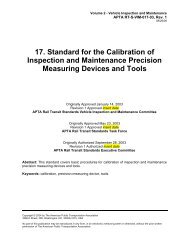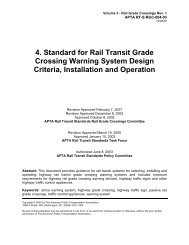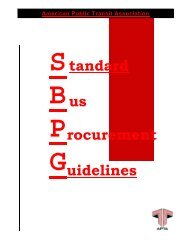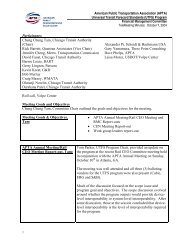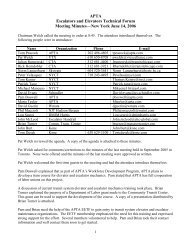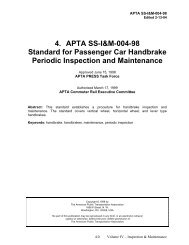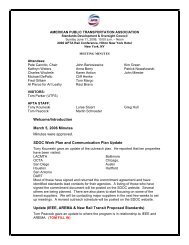Table of Contents - APTAStandards.com
Table of Contents - APTAStandards.com
Table of Contents - APTAStandards.com
Create successful ePaper yourself
Turn your PDF publications into a flip-book with our unique Google optimized e-Paper software.
4.4.4.3 System and Device Data<br />
Most <strong>of</strong> the system and device data messages can be represented with the Condition,<br />
Variable and the File Management Dialogues as explained in the previous sections.<br />
However,<br />
Program Execution Dialogue is the most suitable for Device Command<br />
messages. A Program Execution is an action or set <strong>of</strong> actions to be carried out by the<br />
CID. The format <strong>of</strong> this dialogue is illustrated in Exhibit 4.4-7.<br />
Exhibit 4.4-7 Program Execution Dialogue<br />
Field Description <strong>of</strong> Field/Attributes<br />
1 Message Header<br />
2 Program Needing Input<br />
3 Program Producing Output<br />
4 Program Name<br />
5 Parameter List<br />
Program Name is the same format as the File Name explained in the previous section.<br />
The Parameter List consists <strong>of</strong> parameters that are unspecified and in ASCII Text<br />
forma t.<br />
4.4.4.4 Event Data<br />
The event data messages are represented by Condition Dialogues (Appendix B).<br />
4.4.4.5 Peer to Peer Clearing & Settlement<br />
The VEI does not define any clearing and settlement related messages.<br />
4. 4.5 Data Elements<br />
Wh ile V EI was not designed with smart cards in mind, it is a flexible protocol and can<br />
be extended to include smart card related data elements. It is also possible to define<br />
implementation<br />
specific data types within the protocol when used within a closed<br />
system; although the greatest benefit is obtained by using VEI in its standard identifiers.<br />
4.4.6 Message Sequences<br />
The VEI provides a simple structure <strong>of</strong> dialogue exchanges between a requester and a<br />
responder. A dialog consists <strong>of</strong> a request message, a response message( s) and<br />
sometimes<br />
an acknowledgement <strong>of</strong> the response(s). A request message with or without<br />
data may require a response at the discretion <strong>of</strong> the requester. A response message that<br />
contains data may require an acknowledgement, at the discretion <strong>of</strong> the responder.<br />
However,<br />
some responses contain no data and act as acknowledgements. In this case<br />
no<br />
separate acknowledgement message is required.<br />
Page 44



